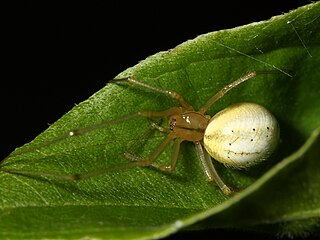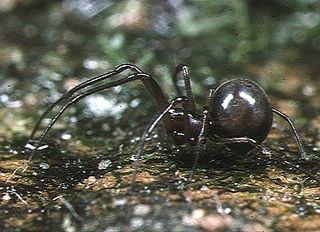
The family Dipluridae, known as curtain-web spiders are a group of spiders in the infraorder Mygalomorphae, that have two pairs of booklungs, and chelicerae (fangs) that move up and down in a stabbing motion. A number of genera, including that of the Sydney funnel-web spider (Atrax), used to be classified in this family but have now been moved to Atracidae.

The spider family Liphistiidae, recognized by Tamerlan Thorell in 1869, when broadly circumscribed to include two subfamilies, comprises 8 genera and about 100 species of medium-sized spiders from Southeast Asia, China, and Japan. They are among the most basal living spiders, belonging to the suborder Mesothelae. In Japan, the Kimura spider is well known. In 2022, it was proposed to re-accept the subfamily Heptathelinae as the family Heptathelidae. As of December 2023, this proposal was accepted by the World Spider Catalog. In this circumscription, the family Liphistiidae has only one genus, Liphistius.

Theridiidae, also known as the tangle-web spiders, cobweb spiders and comb-footed spiders, is a large family of araneomorph spiders first described by Carl Jakob Sundevall in 1833. This diverse, globally distributed family includes over 3,000 species in 124 genera, and is the most common arthropod found in human dwellings throughout the world.

Linyphiidae, spiders commonly known as sheet weavers, or money spiders is a family of very small spiders comprising 4706 described species in 620 genera worldwide. This makes Linyphiidae the second largest family of spiders after the Salticidae. The family is poorly understood due to their small body size and wide distribution; new genera and species are still being discovered throughout the world. The newest such genus is Himalafurca from Nepal, formally described in April 2021 by Tanasevitch. Since it is so difficult to identify such tiny spiders, there are regular changes in taxonomy as species are combined or divided.

Theridiosomatidae, commonly known as Ray Spiders, are a family of araneomorph spiders first described by Eugène Simon in 1881. The family includes 137 species divided between 20 genera. They are most recognizable for their construction of cone-shaped webs.

Telemidae, also known as long-legged cave spiders, is a family of small haplogyne spiders. Most are cave dwelling spiders with six eyes, though some do not have any eyes at all. There are about 104 described species in sixteen genera.

Tetrablemmidae, sometimes called armored spiders, is a family of tropical araneomorph spiders first described by Octavius Pickard-Cambridge in 1873. It contains 126 described species in 29 genera from southeast Asia, with a few that occur in Africa and Central and South America. Pacullidae was incorporated into this family in 1981, but was later restored as a separate family in a 2016 phylogenetic study.

Anapidae is a family of rather small spiders with 232 described species in 58 genera. It includes the former family Micropholcommatidae as the subfamily Micropholcommatinae, and the former family Holarchaeidae. Most species are less than 2 millimetres (0.079 in) long.

Coddingtonia is a genus of Asian ray spiders that was first described by J. A. Miller, C. E. Griswold, & C. M. Yin in 2009. It is a senior synonym of Luangnam.
Dippenaaria is a genus of African araneomorph spiders in the family Anapidae, containing the single species, Dippenaaria luxurians. It was first described by J. Wunderlich in 1995, and has only been found in South Africa. The genus was named in honour of South African arachnologist Ansie Dippenaar-Schoeman.
Penangodyna is a monotypic genus of Southeast Asian cribellate araneomorph spiders in the family Dictynidae containing the single species, Penangodyna tibialis. It was first described by J. Wunderlich in 1995, and has only been found in Malaysia.
Telemofila is a genus of long-legged cave spiders that was first described by J. Wunderlich in 1995. As of September 2019 it contains two species, found on Sumatra and New Caledonia: T. pecki and T. samosirensis.
Erigophantes is a monotypic genus of Indonesian dwarf spiders containing the single species, Erigophantes borneoensis. It was first described by J. Wunderlich in 1995, and has only been found on Borneo.
Knischatiria is a genus of dwarf spiders that was first described by J. Wunderlich in 1976. As of May 2019 it contains only three species, found in Australia, Indonesia, and Malaysia: K. abnormis, K. longispina, and K. tuberosa.
Borneoridion is a monotypic genus of comb-footed spiders containing the single species, Borneoridion spinifer. It was first described by C. Deeleman & J. Wunderlich in 2011, and is found on Borneo.
Cameronidion is a monotypic genus of Malaysian comb-footed spiders containing the single species, Cameronidion punctatellum. It was first described by J. Wunderlich in 2011, and is found in Malaysia.
Grancanaridion is a monotypic genus of comb-footed spiders containing the single species, Grancanaridion grancanariense. It was first described by J. Wunderlich in 2011, and is found on the Canary Islands.

Simitidion is a genus of comb-footed spiders that was first described by J. Wunderlich in 1992. As of June 2020 it contains three species, native to Africa, Asia and Europe, and introduced to Canada: S. agaricographum, S. lacuna, and S. simile.
Tamanidion is a monotypic genus of Asian comb-footed spiders containing the single species, Tamanidion multidenticuli. It was first described by J. Wunderlich in 2011, and is found in Malaysia.
Chthonopes is a genus of southeast Asian ray spiders that was first described by J. Wunderlich in 2011. As of June 2020 it contains three species, found in caves of Laos, but can likely also be found in India and China: C. cavernicola, C. jaegeri, and C. thakekensis. They have several adaptations for darker environments, including pale coloration, long legs, and reduced lenses.









